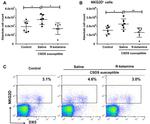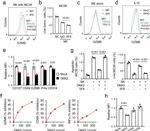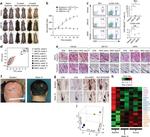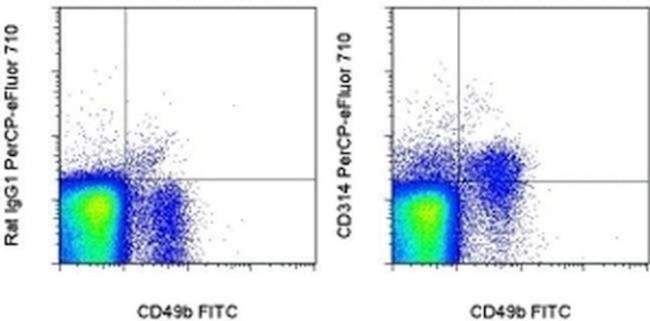Search Thermo Fisher Scientific
Invitrogen
CD314 (NKG2D) Monoclonal Antibody (CX5), PerCP-eFluor™ 710, eBioscience™
FIGURE: 1 / 7
CD314 (NKG2D) Antibody (46-5882-82) in Flow







Product Details
46-5882-82
Species Reactivity
Published species
Host/Isotype
Recommended Isotype Control
Class
Type
Clone
Conjugate
Excitation/Emission Max
Form
Concentration
Purification
Storage buffer
Contains
Storage conditions
Shipping conditions
RRID
Product Specific Information
Description: The CX5 monoclonal antibody reacts with the mouse NKG2D, a lectin-like molecule expressed on both human and mouse NK cells. mouse NKG2D binds to retinoic acid-inducible RAE-1 alpha, beta, gamma, delta, epsilon and the minor histocompatibility molecule H60 and has the ability to costimulate multiple NK activation receptors, through the DAP12/DAP10 adaptor molecules. NKG2D is expressed by all spleen and liver NK cells, NK1.1^+ thymocytes, in vitro activated LAK cells, and a subset of splenic NKT cells.
Applications Reported: This CX5 antibody has been reported for use in flow cytometric analysis.
Applications Tested: This CX5 antibody has been tested by flow cytometric analysis of mouse splenocytes. This can be used at less than or equal to 0.5 µg per test. A test is defined as the amount (µg) of antibody that will stain a cell sample in a final volume of 100 µL. Cell number should be determined empirically but can range from 10^5 to 10^8 cells/test. It is recommended that the antibody be carefully titrated for optimal performance in the assay of interest.
PerCP-eFluor® 710 emits at 710 nm and is excited with the blue laser (488 nm); it can be used in place of PerCP-Cyanine5.5. We recommend using a 710/50 bandpass filter, however, the 695/40 bandpass filter is an acceptable alternative. Please make sure that your instrument is capable of detecting this fluorochrome.
Fixation: Samples can be stored in IC Fixation Buffer (Product # 00-822-49) (100 µL of cell sample + 100 µL of IC Fixation Buffer) or 1-step Fix/Lyse Solution (Product # 00-5333-54) for up to 3 days in the dark at 4°C with minimal impact on brightness and FRET efficiency/compensation. Some generalizations regarding fluorophore performance after fixation can be made, but clone specific performance should be determined empirically.
Excitation: 488 nm; Emission: 710 nm; Laser: Blue Laser.
Filtration: 0.2 µm post-manufacturing filtered.
Target Information
Natural killer (NK) cells are lymphocytes that can mediate lysis of certain tumor cells and virus-infected cells without previous activation. NK cells can regulate specific humoral and cell-mediated immunity, and preferentially express several calcium-dependent (C-type) lectins, which have been implicated in the regulation of NK cell function. The NK gene encodes a member of the NKG2 family, and the encoded transmembrane protein is characterized by a type II membrane orientation (extracellular C terminus) and the presence of a C-type lectin domain. The NKG2 gene family is located within the NK complex, a region that contains several C-type lectin genes preferentially expressed in NK cells.
For Research Use Only. Not for use in diagnostic procedures. Not for resale without express authorization.
How to use the Panel Builder
Watch the video to learn how to use the Invitrogen Flow Cytometry Panel Builder to build your next flow cytometry panel in 5 easy steps.
Bioinformatics
Protein Aliases: CD314; Killer cell lectin-like receptor subfamily K member 1; natural killer cell group 2D; natural killer cell receptor; NK cell receptor D; NKG2-D type II integral membrane protein; NKG2-D-activating NK receptor
Gene Aliases: D6H12S2489E; Klrk1; NKG2-D; Nkg2d
UniProt ID: (Mouse) O54709
Entrez Gene ID: (Mouse) 27007

Performance Guarantee
If an Invitrogen™ antibody doesn't perform as described on our website or datasheet,we'll replace the product at no cost to you, or provide you with a credit for a future purchase.*
Learn more
We're here to help
Get expert recommendations for common problems or connect directly with an on staff expert for technical assistance related to applications, equipment and general product use.
Contact tech support

